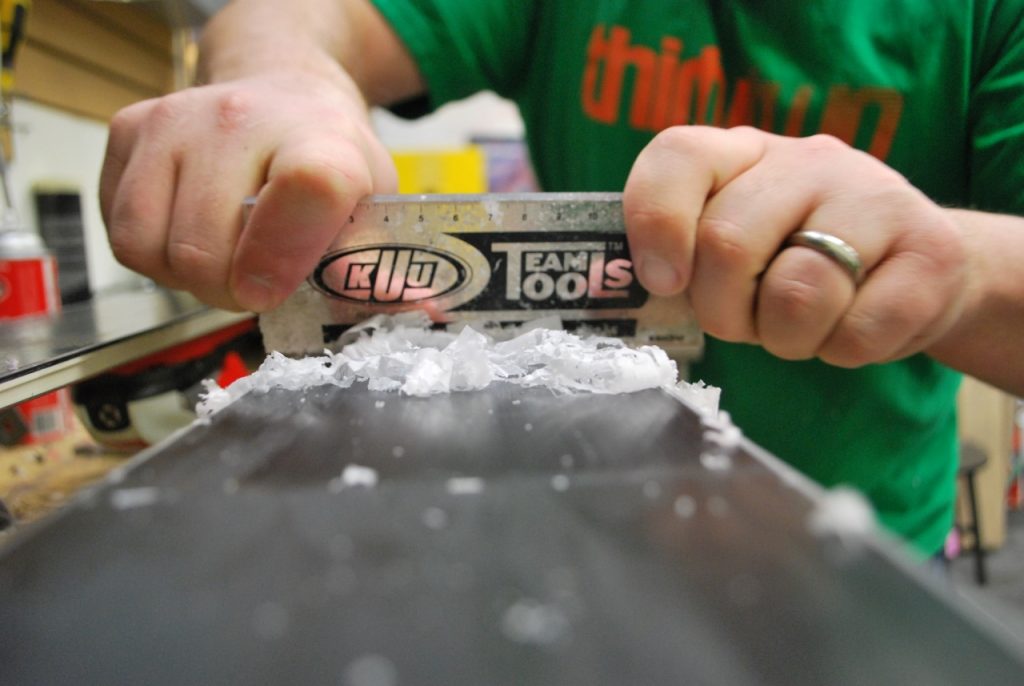Ski are expensive bits are kit and its only common sense that they need caring for. After all, your skis are the only thing between you and the snow. There are the thing that gives you the rush when you’re whizzing down the slopes. One thing you should know how to do is to wax your skis. Why let pay for someone to do it for you when it’s straight forward to do it yourself? Besides, there is nothing better than skiing on freshly waxed skis!
Waxing has a couple of purposes. Firstly, it either enables the skis to glide better on the snow. Or secondly and alternatively, it'll help you to have a better grip on the snow.
Given that there are various weather conditions, varieties of snow and skiing style; it will bear relevance on which type of ski wax to use. Essentially, there are three kinds of ski wax a skier has to be familiar with; base wax, grip wax and glide wax.
Base wax
Pro skiers might tell you to firstly protect your skis with base-conditioning wax. This kind is typically used as a primer for the grip wax. It is also the maximum common ski wax used by newbie skier. Often, base wax comes in a tin. When applied, it must be heated with a flat iron. Then rubbed into the underside of the ski. Sometimes an aerosol is also included with this wax which may be sprayed into the skis.

Grip wax
Commonly used for cross-country skiing, this is a sticky sort of ski wax. It's applied to the middle of the ski so that after the skier presses the ski down, it grips on the snow quite well. There are two variations of grip wax:
Hard Kick: Comes in a tin and is best suited for fresh new snow. It’s rubbed onto the skis until the wax smooth layer. Some people use a block of cork to rub it into the skis.
Klisters: Comes in a tube rather than a tin and is rather stickier than the Hard Kick. It is best suited to icy conditions.
Glide wax
As beginner skiers, we could understand the purpose of each type of ski wax. That’s why most of them used just one type of wax. For the more advance there is no longer just one general purpose glide wax as there used to be. With technological advances, there are now four colour codes types of glide wax. All for achieving the best performance depending on the snow conditions.
Purple: best suited for slushy conditions.
Blue: for dry hard crusted snow.
Violet: it works well on a soft snow.
Green: Perfect for cold and dry powder snow; the skiers dream.
Although you do not have to use glide wax every time take your skis out; It is recommended to glide wax your skis frequently.
How to wax your skis
- First and most importantly, make sure that your skis are at room temperature. That is extremely important if you don’t want the base of your skis to warp. Skiing on warped skis is a disaster waiting to happen and will ruin your skis. So, if you’ve come in from being on the slopes, then you’ll need to wait at least 30 mins in room temperature to warm up your skis. Of course, if you wipe the excess snow and water off your skis they will warm up quicker.
- Wipe the bottom of your skis with an appropriate base cleaner. The base cleaner is a specifically designed fluid to remove dirt, old wax and other grim and substances. Once thoroughly cleaned, apply a layer of cleaner fluid to the whole base and let it dry.
- Use suitable wax as we mentioned earlier. Obviously, make certain to use a ski wax and not just any kind other wax. If you’re on a budget, research suppliers on the internet. Just make sure is a good ski wax. You can also ask the people in a ski hire shop, what wax to they used and they have to wax 100’s of skis!
- Time to apply the ski wax. Follow the instructions! The application of ski wax is quite simple; Just make sure you apply and rub it in evenly. Applying it excessively won’t make the job quicker. If anything, you’ll just be wasting valuable ski wax.
- If it’s a base wax you’re applying, its likely you’ll need an iron. Use the iron to warm up ski. There are specifically designed ski irons made for waxing skis. You can buy them on the internet or simply find one that does NOT have holes in the bottom. Don’t get a steam iron! It must be a flat smooth iron. You don’t want to clog the iron up with molten wax. It doesn’t have to be too hot either. Just warm enough to soften the wax. Iron your ski as if you are ironing your shirt. Iron along the length of the ski and not side to side. The purpose of ironing is the allow the wax to absorb into the ski itself.
- Allow your skis to cool. Lay your where they can’t be disturbed or touched whilst they cool. It may take a little while for your skis to cool and for the ski to absorb the wax. Don’t touch the warm wax with your fingers. Your hands contain oils that should not make its way only your skis.
- Remove and excess wax. After the wax have completely cooled down, you’ll need to scrape off any excess wax that was not absorbed with into the base. There are purpose made ski wax scrapers you can buy. They're typically made of plastic. If you don’t have one, an ice scraper is a good alternative. A simple shave or two along the base is all that is needed. Don’t shave too much.
- Polish your skis. Polishing your skis will not only give them a shine, it will help distribute the wax evenly and smoothly. A nylon pad or cork block will work well. Polish with nice long strokes, from tip to tail which will give it a nice looking end. You can carefully use a brush to remove and excess or debris
- That’s it. Your skis are ready to take out onto the slopes again

Regardless of the snow conditions and your skiing style, you’ll need to carry out proper maintenance of your skis which includes waxing. It’s extreme gratifying to wax your own skis. All you need is ski wax, an iron, a wax scraper and a brush. After waxing your skis, not only will they perform better, but you will be a safer skier and your skis will last longer.

